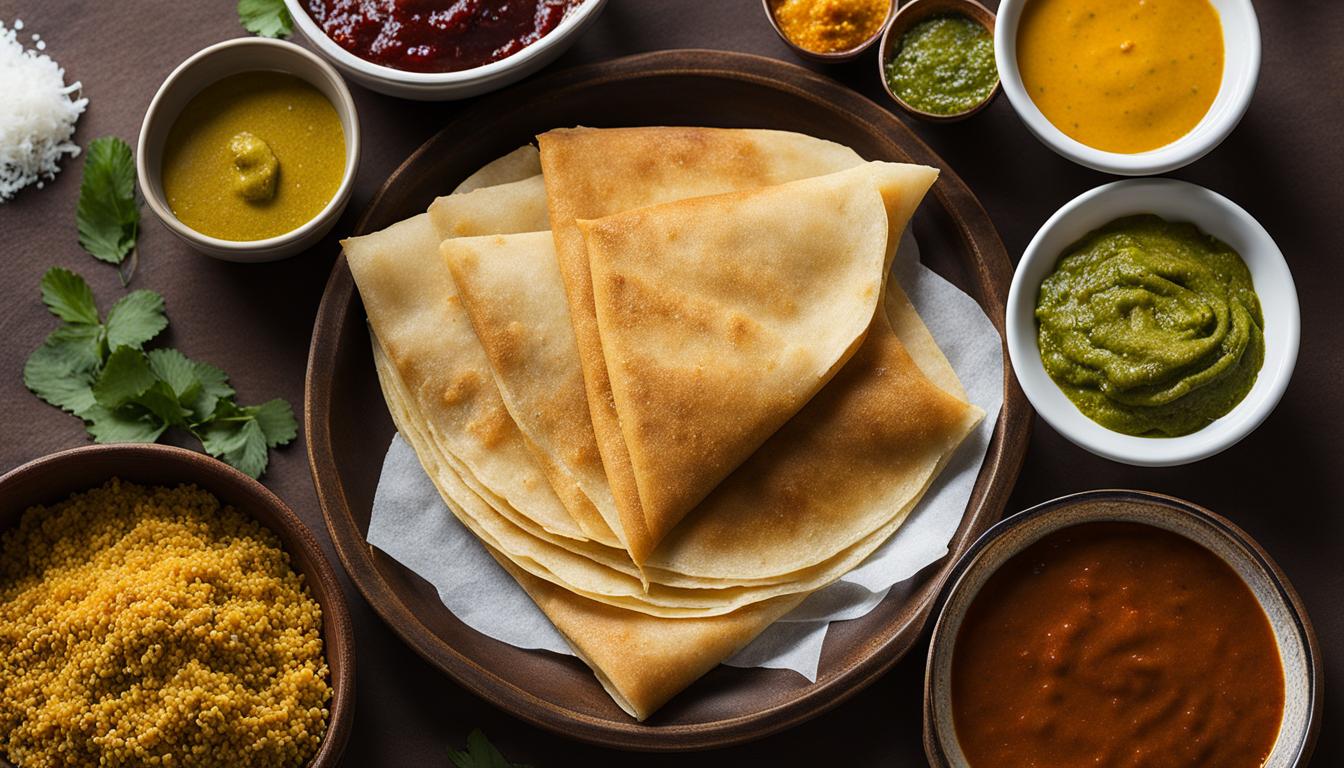Have you ever tasted the irresistible combination of crispy, golden brown crepes with a tangy flavor and light, airy texture? Meet dosa, the classic Indian dish that has been captivating taste buds for centuries. Made from a batter of rice and lentils, dosa is a savory crepe that is as versatile as it is delicious.
But what makes dosa such a beloved dish? How can you make a perfectly crispy dosa at home? And is it true that dosa is a vegan and gluten-free delight? Let’s dive into the world of dosa and unlock its secrets.
In this article, we’ll uncover the art of making dosa, from preparing the batter to achieving that golden brown goodness. We’ll also share tips and tricks to help you perfect your dosa-making skills. Whether you’re a dosa lover or new to this South Indian delicacy, get ready to embark on a flavorful journey that will leave you craving for more.
The Art of Making Dosa
Making dosa is an art that requires attention to detail and practice. To create the perfect dosa, we start by blending soaked rice and lentils into a smooth paste. This batter is the foundation of a delicious dosa. The next crucial step is fermentation, which not only enhances the tangy flavor but also gives the dosa its light and airy texture.
Once the batter is ready, we move on to the cooking process. A well-seasoned cast iron griddle is essential for achieving the desired crispy texture. We spread a ladleful of batter onto the hot griddle, ensuring it spreads evenly to form a thin crepe. Cooking the dosa requires patience as we wait for it to turn golden brown and become crispy.
Now comes the exciting part – filling the dosa! Dosas can be filled with a variety of ingredients, adding layers of flavors. One popular filling option is spiced potatoes, where boiled potatoes are sautéed with aromatic spices like cumin, mustard seeds, and turmeric. This filling adds a satisfying element to the dosa, creating a delightful contrast with the crispy exterior.
Aside from fillings, dosas can also be served plain or with chutney and sambar on the side. The combination of the dosa’s inherent tanginess and the flavorful accompaniments creates a truly satisfying culinary experience.
There are also several variations of dosa that offer a unique twist to this classic dish. Rava dosa, for example, is made using a batter of rice and semolina, resulting in a crispy, lacy texture. Ragi dosa, on the other hand, incorporates the nutritious finger millet, giving it a distinct flavor and color.
Mastering the art of dosa-making requires finding the right balance between the ratio of rice to lentils, perfecting the fermentation process, and becoming proficient in the cooking technique. With practice and dedication, you too can create crispy dosas with mouthwatering fillings and exciting variations.
Tips for Perfecting Your Dosa
To make the perfect dosa, there are a few tips to keep in mind. Firstly, using high-quality ingredients like long-grain rice and urad dal is important for achieving the desired texture and flavor. The ratio of rice to lentils should be adjusted according to personal preferences, with a 3:1 ratio being a good starting point. Adding fenugreek seeds during soaking can help speed up the fermentation process and add flavor to the batter. Using an immersion circulator or multi-cooker can provide a quicker and more consistent fermentation.
It is also important to cook the dosa on a well-seasoned cast iron griddle to ensure even cooking and crispy results. Experimenting with different fillings, spices, and variations of dosa can add variety and excitement to this classic dish. With practice and patience, anyone can master the art of making dosas.
So go ahead, explore the world of dosa spices, try out different dosa variations, and learn how to make dosa like a pro. Elevate your cooking skills and impress your family and friends with the flavorful and delicious dosas you create. Happy dosa-making!
